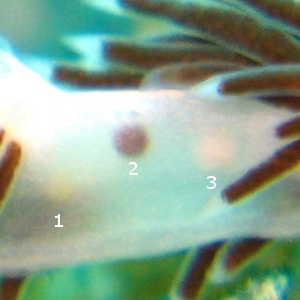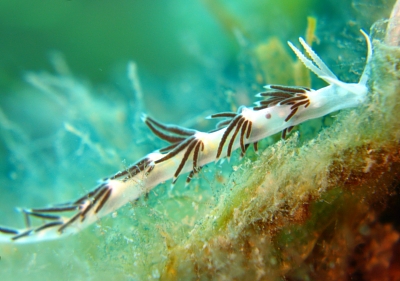Piseinotecus gabinieri - anatomical features
May 2, 2008
From: Dominique Horst

Concerning message #20009:
Hello Bill,
For the second time I have found Piseinotecus gabinieri.
On the first photo, a double hole can be seen on the upper part of the mantle. Is this the reproductive duct?
In the lower photo, I've noticed yellow and one dark purple spots.
Not sure if these spot are something visible by transparency or coloured spots on the mantle? They are not visible on the other side. Are these spots in N.Vicente's description ? On M. Pontes photo, yellow spots are also visible...
Locality: Villefranche sur mer, 5 m, France, Mediterranean sea, 27 April 2008. Length: 20 mm. Photographer: Dominique Horst.
Kind regards,
Dom.
http://www.bathymed.net/crbst_274.html
dominique.horst@wanadoo.fr



Dear Dom.,
Thanks for these photos which show us some interesting anatomical features. Sea Slugs have evolved from snails in which all the body openings - kidney, anus, reproductive - opened above the head (because their shell only had one opening). I briefly discuss on the Detorsion page how with the gradual loss of the shell, slugs began to untwist until we reach groups like the dorids in which the anus is back in the posterior midline like most other animals. However during this clockwise untwisting, not all groups untwisted as much as others and so these openings can be found at various places down the right side of the body. In the aeolids, all the openings, including the anus, stopped somewhere in the upper half of the right side. In your upper photo, the left (and larger) of the two opening is the anus, and the smaller one alongside is the kidney. The common genital opening can't be seen, but it will be a little bit further forward under the anterior clump of cerata. In your lower photo there is a whitish mass just in front and below the first cerata which could be the genital opening. I couldn't see any detail in the large file you sent me so I have not included a close-up.
Now for the spots. Vicente did not mention them in his description. Perhaps they were not visible in his specimens. They are not pigment on the skin but are internal structures.
[1] The yellow spots are part of the reproductive system. They are lobules of the ovotestis, and each produces eggs and sperm. In mature aeolids, variously coloured 'balls' like this are often visible through the body wall.
[2] The brown or purple spot is, I suspect, a bolus of waste from the digestive gland making its way down the intestine to the anus. If you look carefully you can just make out the anus and kidney as dull dark spots just above the brown ball.
[3] The pinkish spot is part of the reproductive system. I am not sure which part, but the glands that make the capsule around each egg, the egg case, and and prostatic fluid, and sacs that store the sperm, are all together in a mass near the genital opening.
Hope that all makes sense. Thanks also for the url to your growing website. It is good to get such nice groups of photos of your wonderful fauna.
Best wishes,
Bill Rudman
Related messages
-
Piseinotecus gabinierei - egg ribbon?
From: Miquel Pontes, November 7, 2008 -
Re: Piseinotecus gabinieri - rings on rhinophores
From: Dominique Horst, May 2, 2008 -
Piseinotecus gabinieri - rings on rhinophores
From: Miquel Pontes, June 26, 2007 -
Re: Aeolid from Peru
From: Francis & Pirjo Pellet, November 16, 2005 -
Piseinotecus gabinierei from France
From: Marina Poddubetskaia, October 11, 2003 -
Piseinotecus gabinierei from Turkey
From: Ferda Buyukbaykal, October 11, 2003 -
Piseinotecus gabinierei from Turkey
From: Haluk Akbatur , March 21, 2003 -
Piseinotecus gabinierei? from Turkey
From: Baki Yokes, June 8, 2002 -
Re: Spelling of Piseinotecus gabinierei
From: Juan Lucas Cervera, January 22, 2001 -
Spelling of Piseinotecus gabinierei
From: Erwin Koehler, January 18, 2001 -
Piseinotecus gabinieri from Mediterranean
From: Erwin Koehler, September 15, 2000
